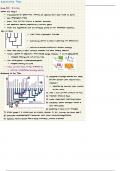Phylogenic trees - Study guides, Class notes & Summaries
Looking for the best study guides, study notes and summaries about Phylogenic trees? On this page you'll find 10 study documents about Phylogenic trees.
All 10 results
Sort by

-
Biology 1108 Final Exam Quiz Questions with 100% pass
- Exam (elaborations) • 15 pages • 2024
- Available in package deal
-
- $12.49
- + learn more
Biology 1108 Final Exam Quiz Questions with 100% pass The term "n" refers to the size of a population, that is, the number of individuals in that population. In general, in a sample of n individuals, the frequency of an allele is: - Correct Answer ️️ -the number of occurrences of the allele divided by twice the number of individuals in the sample (2n) If a population is not in Hardy-Weinberg equilibrium, we can conclude that: - Correct Answer ️️ -evolution has occurred because on...

-
Biology 1108 Final Exam Quiz Questions with 100% pass
- Exam (elaborations) • 15 pages • 2024
-
- $12.49
- + learn more
Biology 1108 Final Exam Quiz Questions with 100% pass The term "n" refers to the size of a population, that is, the number of individuals in that population. In general, in a sample of n individuals, the frequency of an allele is: - Correct Answer ️️ -the number of occurrences of the allele divided by twice the number of individuals in the sample (2n) If a population is not in Hardy-Weinberg equilibrium, we can conclude that: - Correct Answer ️️ -evolution has occurred because on...

-
Biology 1108 Final Exam Quiz Questions with 100% pass
- Exam (elaborations) • 15 pages • 2024
- Available in package deal
-
- $12.49
- + learn more
Biology 1108 Final Exam Quiz Questions with 100% pass The term "n" refers to the size of a population, that is, the number of individuals in that population. In general, in a sample of n individuals, the frequency of an allele is: - Correct Answer ️️ -the number of occurrences of the allele divided by twice the number of individuals in the sample (2n) If a population is not in Hardy-Weinberg equilibrium, we can conclude that: - Correct Answer ️️ -evolution has occurred because on...

-
NDSU microbiology 350 exam 3 Questions and Correct Answers the Latest Update
- Exam (elaborations) • 12 pages • 2024
- Available in package deal
-
- $11.49
- + learn more
16S rRNA Ribosomal RNA used to identify microorganisms 18S rRNA Ribosomal RNA used for studying evolutionary relationships in eukaryotes Banded Iron Formation Sedimentary rock with iron-rich layers, provides clues about Earth's history Black Queen Theory Organisms rely on helper species to reduce metabolic costs Endosymbiosis Theory of organelles originating from prokaryotic cells in a symbiotic relationship Evolutionary Selection Process of advantageous traits being favored ...
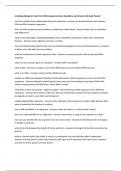
-
creating phylogenic trees form DNA sequences Exam Questions and Answers Already Passed
- Exam (elaborations) • 2 pages • 2024
-
- $7.89
- + learn more
creating phylogenic trees form DNA sequences Exam Questions and Answers Already Passed how do scientists draw relationships between organisms - Answers on shared features and compare DNA and RNA between organisms how are DNA sequences used to deduce evolutionary relationships - Answers they look at similarities and differences what is one advantage of building phylogenic trees using DNA comparisons rather than anatomical features - Answers more adjective and not as unclear how has biotechno...
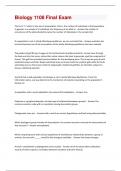
-
Biology 1108 Final Exam Questions With Correct Answers!!
- Exam (elaborations) • 11 pages • 2024
- Available in package deal
-
- $7.99
- + learn more
The term "n" refers to the size of a population, that is, the number of individuals in that population. In general, in a sample of n individuals, the frequency of an allele is: - Answer-the number of occurrences of the allele divided by twice the number of individuals in the sample (2n) If a population is not in Hardy-Weinberg equilibrium, we can conclude that: - Answer-evolution has occurred because one of the assumptions of the Hardy-Weinberg equilibrium has been violated The goldenrod ...
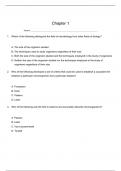
-
Test Bank for Prescott's Microbiology, 12th Edition by Joanne Willey || All Chapters || Updated Version A+
- Exam (elaborations) • 796 pages • 2024
-
- $14.99
- + learn more
Test Bank for Prescott's Microbiology, 12th Edition by JoanneWilleyPrescott's Microbiology, 12e (Willey) Chapter 1 The Evolution of Microorganisms and Microbiology 1) Archaea are cellular organisms that have unique cell membrane . Answer: lipids Topic: Archaea Bloom's/Accessibility: 1. Remember / Keyboard Navigation ASM Topic: Module 02 Cell Structure and Function ASM Objective: 02.03 Bacteria and Archaea have specialized structures (e.g. flagella, endospores, and pili) that often confer c...
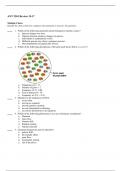
-
Exam (elaborations) ANT 2301
- Exam (elaborations) • 18 pages • 2023
-
- $14.99
- + learn more
. Which of the following statements about biological evolution is false? a. Species change over time. b. Natural selection produces changes in species. c. Individuals in a population evolve. d. Different species may share a common ancestor. e. Most populations are genetically diverse. 2. Which of the following descriptions of the gene pool shown below is correct? a. Population size = 15 b. Number of genes = 2 c. Frequency of X1= 0.80 d. Size of gene pool = 30 e. Frequency of X1X3...
What evolutionary/phylogenic trees are and how to interpret them. Common misconceptions when making and utilizing evolutionary/phylogenic trees.
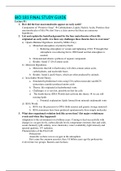
-
BIO 181 FINAL STUDY GUIDE, Latest complete guide (fall 2019/2020)
- Other • 82 pages • 2021
-
- $12.49
- + learn more
BIO 181 FINAL STUDY GUIDE Lecture #1: 1. How did the four macromolecules appear on early earth? Components of “Primitive Soup” Carbohydrates, Lipids, Nucleic Acids, Proteins (four macromolecules of life) We don’t have a clear answer but there are numerous hypotheses. 2. List and explain the basis/ background for the four main theories of how life originated on early earth. Are there any challenges these theories have to overcome? a) Oparin-Haldane Hypothesis (tested by Miller-Urey) a. ...

How much did you already spend on Stuvia? Imagine there are plenty more of you out there paying for study notes, but this time YOU are the seller. Ka-ching! Discover all about earning on Stuvia



